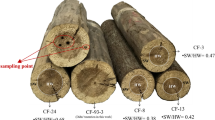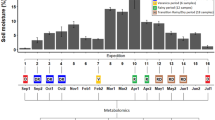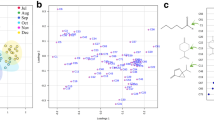Abstract
The principal objectives of the study were to develop metabolomics tool and to test its efficiency for discrimination and biochemical pattern recognition of genotypes and phenotypes of silver birch trees (Betula pendula Roth). In the experiment were used two birch genotypes (GT 2 and GT 5) that have been grown over seven years on the two open fields A and B. The metabolomics tool was applied also to study biochemical responses of the GT 2 to elevated (1.5 × ambient) concentration of ozone as an environmental stress factor. These trees were treated with ozone over seven years using an open-air exposure system. The developed metabolomics tool was based on the analyses of lipophilic and polar compounds of birch leaves with GC-MS and HPLC-DAD (polar phenolics only). The metabolome database included 331 chemical traits and was analyzed with descriptive and multivariate statistics. Application of cluster and principle component analyses clearly discriminated genetically different birch trees. In addition, the genotype clusters were further divided into two subclusters corresponding to trees from field A and field B. Formation of these phenotypes was due to the differences in some environmental conditions between the field A and field B. Biochemical discrimination between phenotypes of control and ozone-treated birch trees of GT 2 was found also. However, distances between these phenotypes, as well as between phenotypes of control trees from the field A and field B were found to be considerably smaller than between birch genotypes. Metabolites with the largest contribution to birch genotype/phenotype discrimination were determined and some were identified.






Similar content being viewed by others
References
Choi, H.-K., Choi, Y., Verberne, M., Lefeber, A. W. M., Erkelens, C., & Verpoorte, R. (2004). Metabolic fingerprinting of wild type and transgenic tobacco plants by 1H NMR and multivariate analysis technique. Phytochemistry, 65, 857–864.
Daub, C. O., Kloska, S., & Selbig, J. (2003). MetaGeneAlyse: Analysis of integrated transcriptional and metabolite data. Bioinformatics, 19, 2332–2333.
Fiehn, O. (2002). Metabolomics––the link between genotypes and phenotypes. Plant Molecular Biology, 48, 155–171.
Fiehn, O., Kopka, J., Dörmann, P., Altman, T., Trethewey, R., & Willmitzer, L. (2000). Metabolite profiling for functional genomics. Nature Biotechnology, 18, 1157–1161.
Halket, J., Przyborowska, A., Stein, S., Down, S., & Chalmers, R. (1999). Deconvolution gas chromatography/mass spectrometry of urinary organic acid––potential for pattern recognition and automated identification of metabolite disorders. Rapid Communications in Mass Spectrometry, 13, 279–284.
Haukioja, E., Ossipov, V., Koricheva, J., Honkanen, T., Larsson, S., & Lempa, K. (1998). Biosynthetic origin of carbon-based secondary compounds: Cause of variable responses of woody plants to fertilization? Chemoecology, 8, 133–139.
Ingestad, T. (1962). Macro element nutrition of pine, spruce and birch seedling in nutrient solutions. Meddelande Statens Skogsforskningsinstitut, 51, 1–133.
Jolliffe, I. T. (1986). Principal component analysis. New York: Springer-Verlag.
Karnosky, D. F., Werner, H., Holopainen, T., Percy, K., Oksanen, T., Oksanen, E., Heerdt, C., Fabian, P., Nagy, J., Heilman, W., Cox, R., Nelson, N., & Matyssek, R. (2007). Free-air exposure systems to scale up ozone research to mature trees. Plant Biology, 9, 181–190.
de Kroone, H., Huber, H., Stuefer, J., & van Groenendael, J. (2005). A modular concept of phenotypic plasticity in plants. The New Phytologist, 166, 73–82.
Kontunen-Soppela, S., Ossipov, V., Ossipova, S., & Oksanen, E. (2007). Shift in birch leaf metabolome and carbon allocation during long-term open-field ozone exposure. Global Change Biology, 13, 1053–1067.
Laurila, T., Tuovinen, J.-P., Tarvainen, V., & Simpson, D. (2004). Trends and scenarios of ground-level ozone concentrations in Finland. Boreal Environment Research, 9, 167–184.
Lavola, A., Julkunen-Tiitto, R., & Pääkkönen, E. (1994). Does ozone stress change the primary or secondary metabolites of birch (Betula pendula Roth)? The New Phytologist, 126, 637–642.
Loponen, J., Ossipov, V., Lempa, K., Haukioja, E., & Pihlaja, K. (1998). Concentrations and among-compound correlations of individual phenolics in white birch leaves under air pollution stress. Chemosphere, 36, 1445–1456.
Oksanen, E. (2003). Responses of selected birch (Betula pendula). clones to ozone change over time. Plant, Cell & Environment, 26, 875–886.
Ossipov, V., Haukioja, E., Ossipova, S., Hanhimäki, S., & Pihlaja, K. (2001). Phenolic and phenolic-related factors as determinants of suitability of mountain birch leaves to an herbivorous insect. Biochemical Systematics and Ecology, 29, 223–240.
Ossipov, V., Nurmi, K., Loponen, J., Haukioja, E., & Pihlaja, K. (1996). HPLC separation and identification of phenolic compounds from leaves of Betula pubescens and Betula pendula. Journal of Chromatography. A, 721, 59–68.
Ossipov, V., Nurmi, K., Loponen, J., Prokopiev, N., Haukioja, E., & Pihlaja, K. (1995). HPLC isolation and identification of flavonoids from white birch Betula pubescens leaves. Biochemical Systematics and Ecology, 23, 213–222.
Ossipova S., Ossipov, V., Haukioja, E., Loponen, J., & Pihlaja, K. (2001). Proanthocyanidins from mountain birch leaves: Quantitation and properties. Phytochemical Analysis, 12, 128–133.
Pell, E. J., Schlagnhaufer, C. D., & Arteca, R. N. (1997). Ozone-induced oxidative stress: mechanisms of action and reaction. Physiologia Plantarum, 100, 264–273.
Peltonen, P. A., Vapaavuori, E., & Julkunen-Tiitto, R. (2005). Accumulation of phenolic compounds in birch leaves is changed by elevated carbon dioxide and ozone. Global Change Biology, 11, 1305–1324.
Riikonen, J., Lindsberg, M.-M., Holopainen, T., Oksanen, E., Lappi, J., Peltonen, P., & Vapaavuori, E. (2004). Silver birch and climate change: variable growth and carbon allocation responses to elevated concentrations of carbon dioxide and ozone. Tree Physiology, 24, 1227–1237.
Roessner, U., Luedemann, A., Brust, D., Fiehn, O., Linke, T., Willmitzer, L., & Fernie, A. (2001). Metabolic profiling allows comprehensive phenotyping of genetically or environmentally modified plant system. Plant Cell, 13, 11–29.
Saleem, A., Loponen, J., Pihlaja, K., & Oksanen, E. (2001). Effects of long-term open-field ozone exposure on leaf phenolics of European silver birch (Betula pendula Roth). Journal of Chemical Ecology, 27, 1049–1062.
Salminen, J.-P., Ossipov, V., Loponen, J., Haukioja, E., & Pihlaja, K. (1999). Characterisation of hydrolysable tannins from leaves of Betula pubescens by high-performance liquid chromatography––mass spectrometry. Journal of Chromatography. A, 864, 283–291.
Sumner, L., Mendes, P., & Dixon, R. (2003). Plant metabolomics: Large-scale phytochemistry in the functional genomics era. Phytochemistry, 62, 817–836.
Taylor, J., King, R. D., Altmann, T., & Fiehn, O. (2002). Application of metabolomics to plant genotype discrimination using statistics and machine learning. Bioinformatics, 18, 241–248.
Trethewey, R. (2001). Gene discovery via metabolic profiling. Current Opinion in Biotechnology, 12, 135–138.
Vinocur, B., & Altman, A. (2005). Recent advances in engineering plant tolerance to abiotic stress: Achievements and limitations. Current Opinion in Biotechnology, 16, 123–132.
Valkama, E., Koricheva, J., Ossipov, V., Ossipova, S., Haukioja, E., & Pihlaja, K. (2005). Delayed induced responses of birch glandular trichomes and leaf surface lipophilic compounds to mechanical defoliation and simulated browsing. Oecologia, 146, 385–393.
Valkama, E., Koricheva, J., & Oksanen, E. (2007). Effects of elevated O3, alone and in combination with elevated CO2, on tree leaf chemistry and insect herbivore performance: A meta-analysis. Global Change Biology, 13, 184–201.
Wang, W., Vinocur, B., Shoseyov, O., & Altman, A. (2004). Role of plant heat-shock proteins and molecular chaperones in the abiotic stress responses. Trends in Plant Science, 9, 244–252.
Acknowledgements
This work was funded by the Academy of Finland, projects 201073 (VO) and 51758 (EO). We thank Timo Oksanen for ozone fumigations.
Author information
Authors and Affiliations
Corresponding author
Rights and permissions
About this article
Cite this article
Ossipov, V., Ossipova, S., Bykov, V. et al. Application of metabolomics to genotype and phenotype discrimination of birch trees grown in a long-term open-field experiment. Metabolomics 4, 39–51 (2008). https://doi.org/10.1007/s11306-007-0097-8
Received:
Accepted:
Published:
Issue Date:
DOI: https://doi.org/10.1007/s11306-007-0097-8




